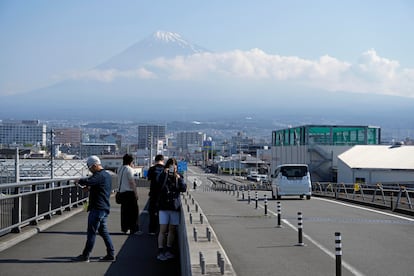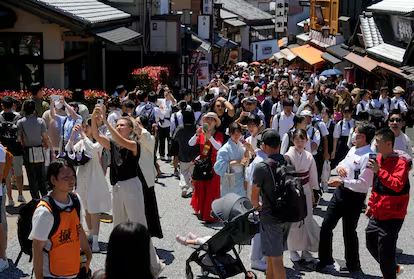Japan’s tourism is a victim of its own success
Faced with the arrival of 33 million travelers taking advantage of the weak yen, the country is taking measures to curb visitor numbers


In a far cry from the isolationist Samurai era, the Land of the Rising Sun has become a victim of its own success when it comes to receiving visitors. A destination that was once considered off the map for the majority of tourists due to its remoteness and the language barrier, Japan has managed to multiply its tourist figures in 2023, making a quantum leap from three to 25 million tourists compared to 2022, according to data from the Japan National Tourism Organization (JNTO). And this tourist tsunami is expected to become even more overwhelming in 2024: the country has already welcomed around 12 million visitors and expects this figure to reach 33 million by December, surpassing 2019′s record of 32 million.
Admiring views of Mount Fuji through the mist or taking a selfie in Kyoto’s geisha district are among the country’s top tourist attractions. Now, however, if visitors try to take the iconic roadside photo of the mountain, their view will be obscured by 1.8-meter fencing that was recently installed by the Ministry of Transportation and Tourism to prevent the flood of visitors to the mountain village of Kawaguchi from collapsing the road. Now, if they want to climb the mountain, they have to pay a tax of 2,000 yen (€11.78 or $12.64).
The sudden uptick in tourist numbers is undoubtedly a consequence of the strategy announced by Japanese Prime Minister Fumio Kishida to push tourist numbers to 60 million annual visitors by 2030. Although more than half the arrivals to Japan have been from other Asian countries, the most considerable increase has been from Mexico, up 104% from before the pandemic, followed by U.S. travelers (47.3%) and Middle Eastern visitors (44.6%), according to the JNTO. The influx of tourists, bolstered by an attractive dollar-yen exchange rate, contributed 5.3 trillion yen (€31.4 billion or $33.7 billion) to the Japanese economy in 2023. In May, the yen hit its lowest level since 1990, at 160 to the dollar, following the Bank of Japan’s historic reversal of its negative interest rate policy in March.

Despite the success of the Prime Minister’s tourist strategy, local areas, burdened by labor shortages, have begun to experience the hidden cost of mass tourism. More than half of Japanese companies say they do not have enough employees, according to a recent survey by Teikoku Databank, a credit research firm. The lack of staff has led to a record number of corporate bankruptcies: 1,016 bankruptcies were recorded in May, with the service and transportation sectors among the hardest hit.
New measures
Famous for its omotenashi or hospitality culture, Japan has had to take sweeping measures, targeting tourism everywhere from Tokyo to the most remote islands. In Shibuya, for example, the capital’s trending district, the authorities have curbed nightlife due to noise and bad behavior. Japan’s islands have also begun to feel the aftershocks of this tourist boom. The surge of foreigners to some remote islands in the Okinawa region has prompted several local governments to impose an entry tax on travelers. Miyajima Island, off the coast of Japan, began to charge 100 yen (€0.59 or $0.63) to foreigners arriving by boat to visit Itsukushima Shrine last October. This may seem negligible, but the local government expects to earn 250 million yen (€1.4 million or $1.5 million) from the fee this year, according to the Japanese media.
Sign up for our weekly newsletter to get more English-language news coverage from EL PAÍS USA Edition
Tu suscripción se está usando en otro dispositivo
¿Quieres añadir otro usuario a tu suscripción?
Si continúas leyendo en este dispositivo, no se podrá leer en el otro.
FlechaTu suscripción se está usando en otro dispositivo y solo puedes acceder a EL PAÍS desde un dispositivo a la vez.
Si quieres compartir tu cuenta, cambia tu suscripción a la modalidad Premium, así podrás añadir otro usuario. Cada uno accederá con su propia cuenta de email, lo que os permitirá personalizar vuestra experiencia en EL PAÍS.
¿Tienes una suscripción de empresa? Accede aquí para contratar más cuentas.
En el caso de no saber quién está usando tu cuenta, te recomendamos cambiar tu contraseña aquí.
Si decides continuar compartiendo tu cuenta, este mensaje se mostrará en tu dispositivo y en el de la otra persona que está usando tu cuenta de forma indefinida, afectando a tu experiencia de lectura. Puedes consultar aquí los términos y condiciones de la suscripción digital.
More information
Últimas noticias
Most viewed
- Oona Chaplin: ‘I told James Cameron that I was living in a treehouse and starting a permaculture project with a friend’
- Sinaloa Cartel war is taking its toll on Los Chapitos
- Reinhard Genzel, Nobel laureate in physics: ‘One-minute videos will never give you the truth’
- Why the price of coffee has skyrocketed: from Brazilian plantations to specialty coffee houses
- Silver prices are going crazy: This is what’s fueling the rally










































